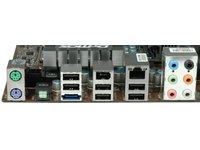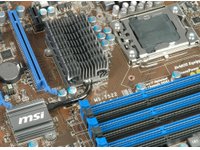Mainstream Or Hardcore? Two X58 Motherboards Compared
You need Intel’s LGA 1366 interface and an X58-based platform in order to run the latest six-core processors, but which board should you pick? We're comparing a mainstream and flagship platform from the same company to explore the worth of high-end X58.
Direct Comparison


The BigBang Xpower has a significant advantage over the X58 Pro-E thanks to its more modern feature set, including such perks as SATA 6Gb/s (two internal ports) and USB 3.0, which the X58 Pro-E lacks. The BigBang’s audio solution is state-of-the-art, and only the high-end board comes with the coaxial and optical S/PDIF ports needed to link the audio system to surround receivers. Both motherboards support at least one eSATA port for external storage devices.


You have a five-phase voltage regulator on the X58 Pro-E versus 16 phases on the BigBang Xpower. The latter required even less idle power and similar peak power. The BigBang would only require higher power during overclocking, which is the platform's true domain. We found that the hardcore motherboard required less voltage to operate at stock speeds, and it required a bit less voltage to run at 4.13 GHz overclocked speed. However, idle voltage would not drop as much on this board, causing higher idle power consumption in overclocked scenarios.
| BIOS | MSI X58 Pro-E | MSI Big Bang Xpower |
|---|---|---|
| CPU | ||
| Turbo Ratio Limit Program | Yes | Yes |
| TDC Limit Override | Yes | Yes |
| TDP Limit Override | Yes | Yes |
| Active Processor Cores | No | Yes |
| Frequency | ||
| CPU Base Frequency | 133 MHz - 400 MHz | 133 MHz - 600 MHz |
| RAM Ratio | 3x - 8x | 3x - 8x |
| Voltage | ||
| CPU Voltage | -320mV - +630 mV | 0.9V - 1.69375 V |
| CPU PLL Voltage | 1.05V - 2.43 V | 1.05V - 2.6 V |
| QPI Voltage | -320mV - +630 mV | 0.88V - 1.6 V |
| DRAM Voltage | 1.2V - 2.77 V | 1.2V - 2.2 V |
| DDR_VREF | 0.435V - 1.05 V | 0.51V - 1.053 V |
| IOH Voltage | Row 14 - Cell 1 | 0.8V - 1.5 V |
| IOH PCIE Voltage | Row 15 - Cell 1 | 1.108V - 1.998 V |
| NB Voltage | 0.8V - 2.37 V | Row 16 - Cell 2 |
| ICH Voltage | 0.7V - 2.13 V | 1.1V - 2.0 V |
Get Tom's Hardware's best news and in-depth reviews, straight to your inbox.
Current page: Direct Comparison
Prev Page BigBang Xpower Features Next Page Overclocking And Feature Comparison